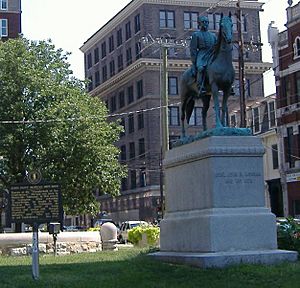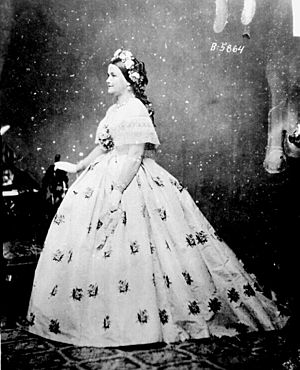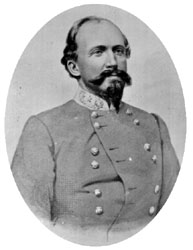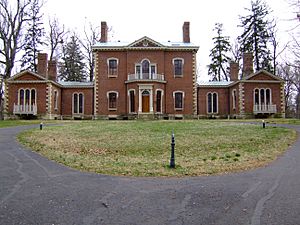Lexington in the American Civil War facts for kids

Lexington, Kentucky, was a very important city during the American Civil War. Many famous people from Lexington were involved in the war, fighting for both the Union (North) and the Confederacy (South). These included John C. Breckinridge, who was a Confederate general, and other Confederate generals like John Hunt Morgan and Basil W. Duke. The Todd family also lived in Lexington. Most of them supported the Confederacy, but one family member, Mary Todd Lincoln, was the First Lady of the United States and the wife of President Abraham Lincoln.
Contents
Lexington's Divided Families During the Civil War

Many families in Lexington were split by the Civil War, with some members supporting the Union and others the Confederacy.
The Todd Family's Civil War Choices
The Todd family was one of Lexington's most well-known families. Mary Todd Lincoln, who later married Abraham Lincoln, was born in Lexington on December 13, 1818. In 1839, she left her family home to live with her sister in Springfield, Illinois. There, she met Abraham Lincoln in 1842. She brought Lincoln back to Lexington in 1847 to meet her family. The Lincolns visited Lexington two more times in 1849 and 1850. The Todd family was deeply divided by the war. Mary's father, Richard Smith Todd, had fourteen children. Six of them chose to support the Union, while eight others joined the Confederacy. Most of the Todds who stayed in Lexington during the war supported the Confederacy.
The Breckinridge and Clay Families
The Breckinridge and Clay families also faced divisions. Robert Jefferson Breckinridge was a strong supporter of the Union in the South. However, his nephew, John C. Breckinridge, who had been Vice President of the United States, joined the Confederacy. Two of Robert J. Breckinridge's sons and a son-in-law also fought for the Confederacy.
The famous statesman Henry Clay had seven grandsons. Three of them fought for the Union (North), and four fought for the Confederacy (South).
In contrast, the Morgan family was united in their support for the Confederacy.
Lexington's Role: 1860 to 1862

Lexington began preparing for war even before Abraham Lincoln was elected president. In March 1860, Kentucky's governor created local defense groups called Home Guards. The Lexington Rifles were the first to join. After Lincoln was elected, the United States flag was no longer flown in the city. When news of the Battle of Fort Sumter reached Lexington, the leader of the Lexington Rifles, John Hunt Morgan, offered help to Confederate President Jefferson Davis. Morgan even raised the Confederate flag over the city's woolen factory.
Early Conflicts in Lexington
The first conflict in Lexington happened in August 1861. About 200 Union cavalry soldiers arrived in the city on August 21. Lexington Home Guard members, who supported the Confederacy, quickly gathered. Former U.S. Vice President John C. Breckinridge, who lived in Lexington, helped negotiate. He allowed the Union cavalry to leave the city safely.
On September 19, a strong Union force returned to Lexington. They had orders to disarm the Home Guard. Captain John Hunt Morgan then led Confederate supporters out of the city to meet other Confederates. The Union forces made Lexington a stronghold. They set up a prison and a hospital in the town.
Confederate Return and Union Retreat

Confederate soldiers returned to Lexington after the Battle of Richmond. On September 2, 1862, Major General Edmund Kirby Smith led 11,000 Confederate soldiers into the city. They found that Union forces had destroyed their supplies before leaving. The people of Lexington cheered for the Confederates. This led General Smith to tell the Confederate government that "the heart of Kentucky is with the South."
After the Battle of Perryville, the Confederates left Lexington on October 8. Union forces returned on October 16. However, on October 18, John Hunt Morgan came back to Lexington. He captured Union Major Charles B. Seidel at Ashland, which was Henry Clay's former home. Morgan re-supplied his men and destroyed the city's military supplies before leaving. During a brief fight, Confederates accidentally fired on other Confederates. This caused John Hunt Morgan's brother, Wash, to be badly wounded. Wash Morgan was taken to the family home, Hopemont, where he later died.
Lexington's Later War Years: 1863 to 1865
In the first three months of 1863, many war refugees who supported the Union arrived in Lexington. These included white people from eastern Tennessee and enslaved people who had escaped.
Morgan's Last Raid on Lexington
John Hunt Morgan made his last return to Lexington on June 8, 1864. He had lost many of his best soldiers in his previous year's Morgan's Raid. Because of this, his remaining men looted the city. They stole at least $13,000 in money and $25,000 worth of horses. Clothing stores were also robbed. Morgan then left for Cynthiana, Kentucky, where he was defeated. This defeat forced him to leave Kentucky for Virginia. Morgan was killed in Greenville, Tennessee, the following September.
In February 1865, John C. Breckinridge was chosen to be the Confederate Secretary of War. After the war ended, he left the country. He was given permission to return in 1868.
After the Civil War in Lexington
In 1868, John Hunt Morgan was reburied in Lexington Cemetery. He and his brother-in-law, Basil W. Duke, are two of seven Civil War generals buried there.
Lexington has four monuments dedicated to the Confederacy. Two of these were originally near the old courthouse: the John Hunt Morgan Memorial (built in 1911) and the John C. Breckinridge Memorial (built in 1887). These two monuments were moved in 2017. The other two monuments are in Lexington Cemetery: the Confederate Soldier Monument in Lexington (1893) and the Ladies' Confederate Memorial (1874). Unlike Louisville, which has monuments for both sides, Lexington does not have any monuments specifically for the Union.

